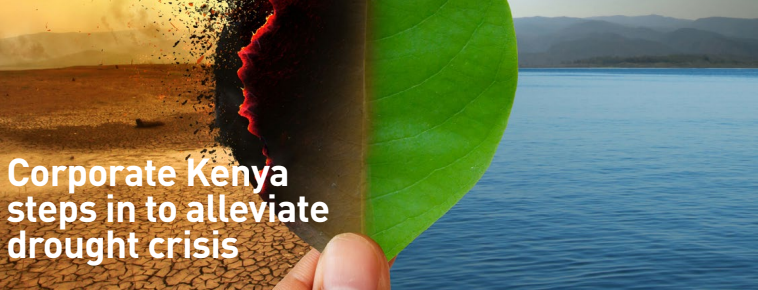Corporate Kenya steps in to alleviate drought crisis

Drought in the Arid and Semi-Arid Lands (ASALs) of Kenya have endured severe droughts in the last decade. The current drought has hit ASAL the hardest with the drought being the most severe and longest.
The drought is attributed to the four failed successive rain seasons with the situation getting worse in 20 out of 23 ASAL counties.
The National Drought Management Authority has updated that 11 of the drought-stricken counties are at the alarm drought phase whereas nine are at the alert drought phase. The other three counties are at the normal drought phase; NDMA estimates that the number of people in need of food assistance is estimated at over 4.5 million. To this end, the government has partnered with development partners and private sectors in the country to respond to the dire drought situation.
Earlier this week, Deputy President Rigathi Gachagua while speaking at Kenya Private Sector Alliance (KEPSA) Pamoja Tuungane Call to Action called upon the private sector to help raise KSh2 billion to be used in feeding people in the ASALs. During the launch of the second Pamoja Tuungane call-to-action with the first one being set up in April 2022, Mr Gachagua commended the private sector for raising over KSh 114 million shillings. The Pamoja Tuungane Call to Action is a private sector initiative towards addressing the dire drought situation in the ASALs.
The Pamoja Tuungane Call to Action is not the first corporate response to drought situation. In 2011 the private sector with support from Kenyans through the Kenyans for Kenya initiative raised KSh1 billion surpassing the KSh500 million target. In 2017, KSh3 million was raised to mobilise drought mitigation by offering cash for livestocks in the ASAL areas.
The Pamoja Tuungane Call to Action took a 3-pronged plan. The short-term plan aims at saving lives whilst the mid-term plan focuses on policy changes. The long-term plan on the other hand will focus on investments such as climate resilient agriculture, strategic water harvesting and storage and food storage. Below are some of the corporate actions towards a long-term solution to the perennial drought situation.
Climate Business Information Network
KEPSA has called upon its members to develop a long-term plan for addressing the drought situation. The long-term plans that run from October 2022 to March 2023 will involve mobilising resources for climate change. Climate change will involve a business network to be known as Climate Business Information Network (CBIN-K) where businesses will integrate and invest in climate action in their structural models for climate adaptation and mitigation. KEPSA’s implementation of CBIN-K will involve; training of businesses, public-private partnerships and development of a nation guide business commitment to climate change.
Commitment to Climate Change
The commitment to climate change by corporates drawn from the private sector strategy on climate change solution in Kenya will support the government’s 15 billion tree planting initiative. The private sector has committed KSh 6 million in terms of seedlings and tree planting initiatives and KSh49 million in cash.
Kenya Plastics Pact
The Kenya Plastic Pact consisting of a multi-stakeholder involving corporates have also committed by 2030 to eliminate single use plastic packaging through redesigning, innovation and reusing business models. The pact commits by 2030 to ensure 100 percent of all plastic packaging will be recyclable with an average of 15% being recycled content in plastic packaging and 40% of the plastic packaging being effectively recycled.
Water sector
The private sector’s plan in the water sector aims at improving access to water for both livestock and agriculture. The private sector aims at developing strategic water harvest and storage facilities in these ASAL areas. These strategies are hoped to align with President William Ruto’s plans of improving access to water in households. The government aims at getting into water purchase agreements with the private sector to develop water supply infrastructure for ease of water supply. Further, to avert the perennial drought situation, the government will also be seeking partnership from the private sector in exploiting irrigation-based agriculture as opposed to rain-fed agriculture.
Data analytics
Development partners such as UNDP called upon the private sector to include non-traditional use of data in recording economic development by encouraging artificial intelligence in gathering data such as livestock numbers. The use of data analytics will encourage innovation in the ecosystem with the private sector aiming at keeping repositories of such information.
Conclusion
In conclusion, the private sector hopes that the long-term investments plans will go a long way in dealing with the drought situation in Kenya while providing long-term solutions to residents from the ASAL areas. Most importantly, it is the hope of the private sector that the United Nations Climate Change Conference (COP27) happening in the next few days in Egypt will raise more commitments by governments in policy changes. The policy changes should focus on addressing the drastic climate changes experienced all over the world. There needs to be a policy change in the use of fossil fuels especially by the developed countries which has largely contributed to the recent severe droughts. The long-term impacts of such policy changes will hopefully change the current drought situation for the better.

